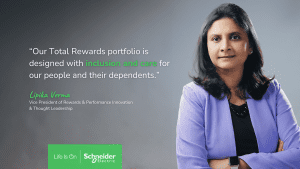Growing up on a small farm, there was an “all hands on deck” mentality, where we did everything ourselves. I inherited an engineering mindset by watching things being pulled apart, repaired and reassembled. The more I investigated their inner workings, the more I became hooked. Working through college and grad school, I earned engineering degrees before deciding where to take my career.
I considered the energy field, but said “no thanks.” Stodgy stereotypes and outdated thinking kept me away, as they had for many women. Being one of few female engineers at that time was challenging enough. I started as a process engineer at General Motors before continuing in global operations at Dell. But years later, here I am — working for Schneider Electric, at the crossroads of energy management and the Internet of Things (IoT). So, what’s changed? A lot, actually.
A modernizing industry
Corporations have become more diverse and inclusive. There are more women on the customer and leadership ends. The end customer is not the male engineer he once was; she is a female CEO or sustainability manager. Her perspective changes business outcomes and rounds out discussions in powerful ways. It makes a difference in our orientation for customers and employees, and offers a rounded view of the problems they face. In encouraging progress at Schneider, we can now report that 42 percent of board members are female, 21 percent of global leadership is female and more than 40 percent of new hires are women.
Major corporations have introduced policies that are more attractive to female professionals. At the very point that many companies are identifying key talent, many women are making family decisions. Progressive companies like ours push the edge with pay equity and global family leave policies to help women manage their unique lives.
Beyond these shifts, it’s just an exciting time to be in energy. Industrial companies are turning into tech companies. We’re fighting climate change through IoT-enabled solutions. We help buildings become more energy efficient and secure, and remote villages more resilient. But even with this positive change, just 20 percent of the energy workforce is female. It’s the second least diverse industry in the country.
Myth busting
When I think about why this might be, I go back to the things that made me say “no” to an energy job at first. There’s also a misconception that the sector is for science-types. I know many women in the field who are successful without engineering degrees. They’re marketers, IT and HR professionals, salespeople, creatives and beyond. There’s no set path into energy. We overthink what a qualified person looks like when what matters most is: great instinct, strong ethics, customer orientation and agility.
It takes all kinds to push the industry forward. But even more compelling is the chance to work for a purpose-driven company that aligns with your beliefs. Like many, I always felt a desire to make a difference in the world. I didn’t know how important it was to me until I started in energy. Schneider believes in access to energy as a basic human right, as do I. My role is helping connect the two billion people that don’t have access to the right level of energy because it changes lives. This motivates me every day.
There’s still work to be done here — but real progress has been made. It’s not the heavy industrial field it once was. Women are needed to drive the transformation for a more sustainable future. Corporations are listening, and policies are shifting. As digitization opens new doors, it’s a great time for women to rethink energy careers, just as I have.
This post originally appeared in Media Planet’s Future of Business Tech.




Conversation
Good work